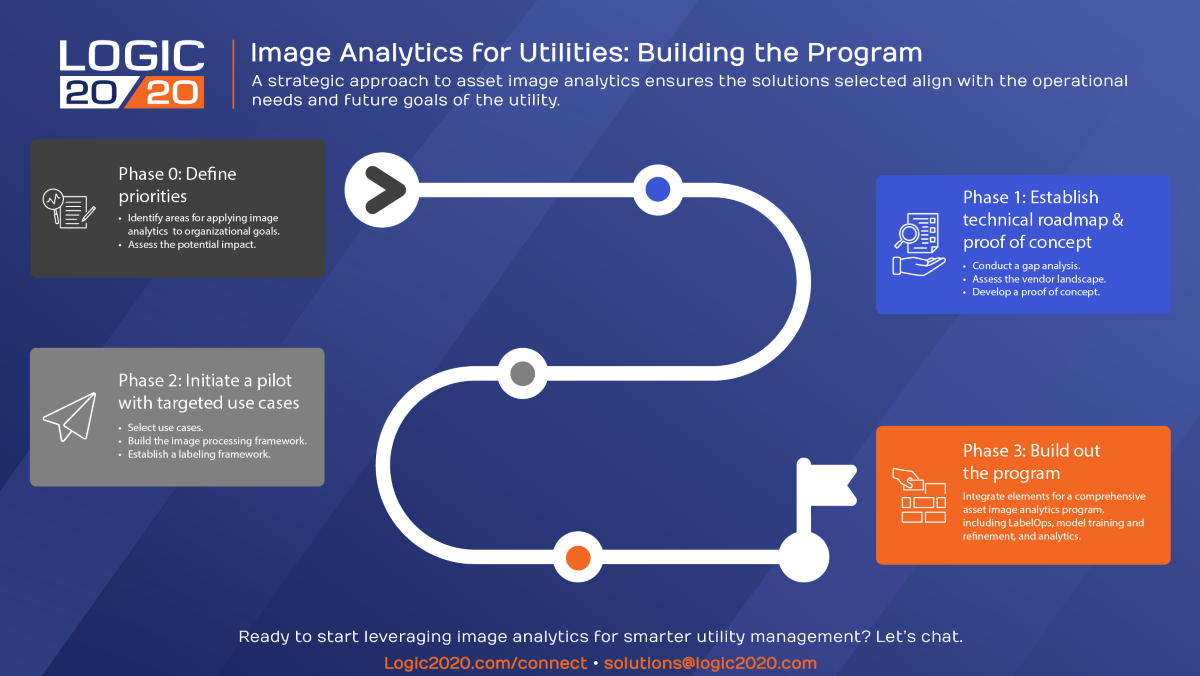3-minute read
Building a comprehensive asset image analytics program is a structured journey that begins with a well-defined technology roadmap and a thorough proof of concept (PoC). This strategic approach ensures the solutions selected align with the operational needs and future goals of the utility.
Here we outline the step-by-step process to establish a solid foundation for an asset image analytics program, ensuring each phase builds upon the last for maximum effectiveness and sustainability.

Phase 0: Define strategic and use case priorities
Imagery allows for advancement in many areas of operations. Before you invest, evaluate where there is potential to apply imagery to your organizational goals and assess the potential impact. A clear value map will allow you to identify the right types of imagery to pilot and to build the business case for execution.
Article continues below
WHITE PAPER
Transforming utility operations with asset image analytics
Phase 1: Establish a technology roadmap and proof of concept
Creating a successful asset image analytics program starts with a solid technology roadmap and an effective PoC. This groundwork ensures that the chosen solutions align with the utility’s operational needs and strategic goals. Here are the steps for progressing through this foundational phase:
1. Conduct a gap analysis
Assess current capabilities versus the desired state and outline the top business cases for asset image analytics.
2. Assess the vendor landscape
Evaluate various technology providers for drones, LiDAR, and satellite imaging solutions.
3. Develop a proof of concept
Building a proof of concept/demo enables the utility to begin implementing asset image analytics in a low-risk scenario as they continue to evaluate the feasibility of the final program. The PoC also provides something tangible to put in front of stakeholders and the chance to solicit their feedback while discovering potential roadblocks on a small scale.
Phase 2: Initiate a pilot with targeted use cases
The pilot phase allows utilities to test and refine the process on a smaller scale (but larger than the proof of concept) before wider implementation. Following are key elements involved in establishing a successful pilot program:
1. Select use cases
Identify specific inspection scenarios that will benefit most from image analytics, such as vegetation management near power lines or structural inspections of aging infrastructure.
2. Build the image processing framework
Develop a robust framework for processing the images captured during the pilot, which requires setting up algorithms for detecting and classifying features or anomalies in the images.
3. Establish a labeling framework
Develop a labeling operations (LabelOps) system for accurately labeling image data to train machine learning models to recognize and interpret the images correctly.
Phase 3: Build out the program
Asset image analytics programs can be built from a total blank slate, or from part of a program already in place. A comprehensive asset image analytics program will incorporate the following elements:
- LabelOps
- Staging and integration
- Model training and refinement
- Process and inference
- Monitoring
- Imagery hub
- Deployment
- Portal
- Integrations (with GIS, etc.)
- Analytics


